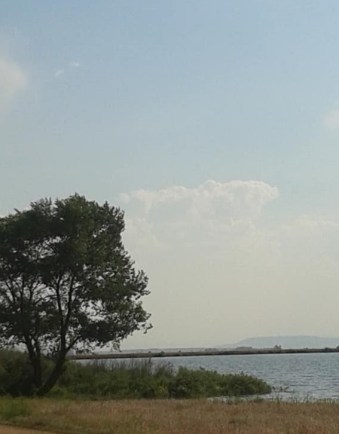To be honest, this is more like a parking lot than a camping area.
Pros: Camping is free there and it’s not far from Socorro, New Mexico. There’s a restroom (pit toilet) on site. The parking area is level. The surrounding nature (especially the giant rock formations) is gorgeous. The road that leads to the area is easy to navigate. It was very quiet the night I stayed there.
Cons: When I was there, the door to the restroom didn’t close completely, which meant it couldn’t be locked. There is nowhere to park a rig where it isn’t on display to everyone else in the parking/camping area. No only is there no privacy in the parking/camping area, there is no shade.
I’d been visiting the Salinas Pueblo Missions Ruins, and Socorro was the next logical stop. I ended up buying a can of beans and dumping my trash at Walmart, fueling up the minivan, and getting a pizza at Little Caesars. I’d been driving and was tired of driving and would be driving the next day. I was ready to stop for the day, chill out, and eat some pizza.
I got on the Free Campsites website and looked for the closest free camping spot that wasn’t Walmart. That place was The Box.
The Box is not far from Socorro, right off Highway 60 and very easy to get to. Once you get off Highway 60, the road is dirt, but well-maintained and easy to navigate. I had no trouble navigating the road in my Toyota Sienna
I’d read reviews of The Box camping area that said it was basically a parking area. Still, I was a bit surprised to find the area is for all intents and purposes a parking lot. It’s not a camping area. It’s a parking area where people camp.

There were no signs that said “no camping” or “no overnight parking,” so I felt fine about staying there. Just know that there are few campground amenities save a pit toilet, a trash can (which had a sign saying there was no trash pickup while I was there), and a single fire ring made from stones. There are no picnic tables and no shade structures. There aren’t any trees to offer any shade. (I came in around 3 o’clock on an overcast afternoon and left in the morning. I didn’t experience the lack of shade myself, but I bet this place bakes at midday, especially in the summer.)
There is a restroom on site. It’s a pit toilet in one of those little square concrete buildings. It was fairly clean and even had toilet paper when I visited in mid-September of 2021. The problem came when I tried to close the door. It wouldn’t close completely. The door wouldn’t fit inside the frame. I tugged on it. I tried slamming it. Nothing worked. I don’t know if the door hadn’t been installed correctly or if a visitor had tried to tear it from its hinges and messed up the whole thing, but the end result was that it wouldn’t close. Because the door didn’t close completely, it didn’t lock either.
After spending several minutes tugging on the door and trying to get it to close properly, my use of the pit toilet had become nonnegotiable. I had to use that toilet even if the door was slightly ajar. I did what I had to do quickly and hoped no one would come along and swing the door wide open while I was in there. No one did.
Over the course of the afternoon, several cars pulled in and people, presumably hikers, disembarked and went off into the wilderness. After a while these people returned to their cars and eventually drove off.
A big group of what seemed to be locals stayed a few hours, having boisterous fun, mostly in the parking area. They left late in the afternoon.
Around twilight a van pulled in and parked next to a pickup truck that had been there for a while. Some young men hung out by the vehicles. One seemed to be cleaning out the van and fussing at the others. Two of the young men played Frisbee in the increasing dark. Other people arrived, but I couldn’t tell if everyone was interacting with each other or if people were sticking to the group they’d arrived with. I wondered if there would be partying into the wee hours, but all was quiet after about 9:30. Even when the people were active, there was no yelling and no loud music, just talking. Once the talking died down, the whole area was very quiet.
If you’re the type to sleep in a tent, there’s plenty of public land right there to pitch it on. Walk out from the parking lot and set up your tent among the majestic rocks.

If you’re like me and sleep exclusively in your rig, you’ll be happy to know the parking area here is very flat. After several nights parked at a slant, I certainly enjoyed sleeping in a bed that was perfectly level.
The Box was not a bad place to spend an afternoon and night. It beat the Walmart parking lot because after the sun set, it was dark and quiet, and I enjoy parking next to nature. I personally would not want to set up camp there for several days, but I liked it for an overnight stop.
I took the photos in this post.





















































































